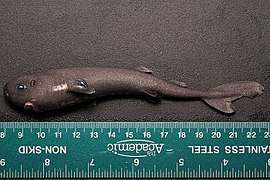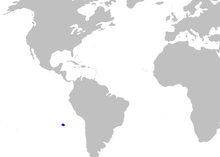Pocket shark
| Pocket shark | |
|---|---|
 | |
| Pocket shark specimen found in the Gulf of Mexico | |
| Scientific classification | |
| Kingdom: | Animalia |
| Phylum: | Chordata |
| Class: | Chondrichthyes |
| Order: | Squaliformes |
| Family: | Dalatiidae |
| Genus: | Mollisquama Dolganov, 1984 |
| Species: | M. parini |
| Binomial name | |
| Mollisquama parini Dolganov, 1984 | |
 | |
| Range of pocket shark (in blue) | |
The pocket shark (Mollisquama parini) is a kitefin shark of the family Dalatiidae, also known as sleeper sharks. The only member of the genus Mollisquama was found in deep water off Chile in the southeast Pacific Ocean and recently in the Gulf of Mexico. It is distinguished from other sharks by two pockets next to its front fins. The pockets are large, measuring about 4% of the shark's body length. Some researchers hypothesize that they may secrete some kind of glowing fluid or pheromones.[1]
Distribution and habitat
The first finding of this species of shark was found off the coast of Chile in the Nazca Submarine Ridge. This specimen was an adolescent female (40 cm total length), taken at a depth of 330 m, in 1979.[1] This initially suggested that the species were distributed throughout the Pacific Ocean. In February 2010, a 14-cm-long specimen was caught 305 km (190 mi) off the coast of Louisiana, in the Gulf of Mexico.[1] It is now believed that they are more widely dispersed than what was previously hypothesized.[2]
Description
The sharks of the family Dalatiidae are small to medium sized with two spineless dorsal fins.[3] They are described to have strong jaws with dagger-like upper teeth and wider blade-like teeth in the lower jaw. From the one finding of the pocket shark in the Gulf of Mexico, the mouth was described to have a rectangular like opening on the underside of the body. The male shark found in the Gulf of Mexico weighed 14.6 g and had a total length of 142.0 mm. The overall shape of the shark is cylindrical where a wide, rounded snout tapers back toward caudal fin.[2]
Pocket gland
The shark Mollisquama parini gets its name from a small pocket gland that is found behind the two pectoral fins on either side of the shark. The purpose of this gland is still unknown as not enough species have been found to investigate the matter. The closest suggestion for the purpose of this gland is to act as a luminous pouch as found on the species Euprotomicroides zantedeschia. While this pocket gland appears to have a slighter dark gray coloration, the rest of the shark’s body is described to be a light gray with brown undertones. The pocket is located approximately 2.5 mm from the base of the pectoral fin and was measured to be 13.0 mm long and 5.0 mm wide.[2]
Environmental threats and conservation
There is essentially no interaction of these sharks with humans so they don’t seem to cause any threat to our environment and other species including humans. No methods of conservation are in place to protect this species as it is unknown as to the population numbers.[4]
References
- 1 2 3 "Jaws meets kangaroo? Rare, cute pocket shark found in deep". Fox News. April 23, 2015. Retrieved April 24, 2015.
- 1 2 3 GRACE, MARK A.; DOOSEY, MICHAEL H.; BART, HENRY L.; NAYLOR, GAVIN J. P. (2015-04-22). "First record of Mollisquama sp. (Chondrichthyes: Squaliformes: Dalatiidae) from the Gulf of Mexico, with a morphological comparison to the holotype description of Mollisquama parini Dolganov". Zootaxa. 3948 (3). ISSN 1175-5334.
- ↑ "DALATIIDAE". fishesofaustralia.net.au. Retrieved 2018-02-26.
- ↑ "Mollisquama parini (Pocket Shark)". www.iucnredlist.org. Retrieved 2018-02-26.
